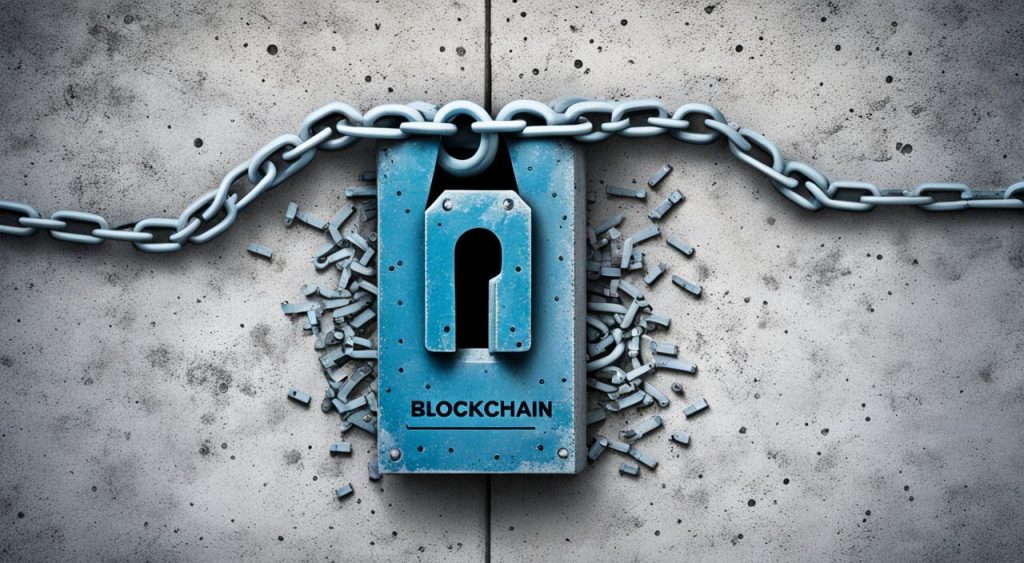- 1. Blockchain’s Decentralized Nature
- 2. Alegality: Operating Beyond Legal Boundaries
- 3. Jurisdictional Challenges
- 4. Navigating Tech Laws
- 5. Governance and Legal Documentation
- 6. Liability and Risk Allocation
- 7. Intellectual Property Considerations
- 8. Data Privacy and Protection
- 9. Conclusion
- 10. FAQ
- 10.1 How is blockchain technology challenging traditional tech laws?
- 10.2 What is “alegality” and how does it relate to blockchain?
- 10.3 What are some of the key jurisdictional challenges posed by blockchain technology?
- 10.4 How can existing regulatory frameworks be interpreted and applied to blockchain technology?
- 10.5 What are the key considerations for establishing governance models and legal documentation for blockchain networks?
- 10.6 How should liability and risk be allocated in a blockchain network?
- 10.7 What are the key intellectual property considerations for blockchain networks?
- 10.8 How do data privacy and protection laws impact blockchain technology?
- 11. Source Links
The rapid advancements in blockchain technology have posed significant challenges to policymakers and regulators around the world. Blockchain and distributed ledger technology offer scalable processing power, high accuracy rates, and unbreakable security at a fraction of the cost of traditional systems. However, as the complexity of these systems increases, vulnerabilities can be introduced, reducing the effectiveness of the blockchain’s security features. Navigating the technology regulations and blockchain legislation surrounding these emerging technologies governance has become a critical concern for businesses and individuals alike.
The cross-border data transfers and ethical AI frameworks that underpin blockchain-based systems further complicate the regulatory landscape, as policymakers struggle to keep pace with the rapid evolution of these technology regulations. Understanding the nuances of this dynamic and rapidly changing field is crucial for anyone seeking to navigate the blockchain legislation and stay compliant with the evolving emerging technologies governance landscape.
Key Takeaways
- Blockchain technology offers significant benefits in terms of scalability, accuracy, and security, but can also introduce vulnerabilities as complexity increases.
- The decentralized nature of blockchain-based systems poses challenges for policymakers and regulators in terms of navigating tech laws and technology regulations.
- Cross-border data transfers and ethical AI frameworks add further layers of complexity to the blockchain legislation and emerging technologies governance landscape.
- Understanding the nuances of this dynamic field is crucial for staying compliant with evolving technology regulations.
- Businesses and individuals must stay informed and adaptable as the blockchain legislation and emerging technologies governance frameworks continue to develop.
Blockchain’s Decentralized Nature
The decentralized nature of blockchain technology poses significant challenges for policymakers and regulators. Public, permissionless blockchain-based networks operate based on a computer protocol enforced by a decentralized network of nodes responsible for processing transactions and recording them into the blockchain. This decentralized structure makes it difficult for governments or other centralized authorities to assert their sovereignty over these networks.
Lack of Central Authority
Unlike traditional financial and digital systems, public blockchains lack a central governing authority. The operations of these networks are determined by the consensus of the decentralized network of nodes, rather than a single controlling entity. This autonomy can make it challenging for regulators to impose their jurisdiction and control over blockchain-based systems.
Distributed Ledger Technology
The distributed ledger technology that underpins blockchain networks allows for the secure and transparent recording of transactions across a decentralized network. Each node in the network maintains a copy of the shared ledger, making it difficult for any single entity to unilaterally alter the data stored on the blockchain. This decentralized data storage and processing model presents unique challenges for data privacy laws, cybersecurity compliance, and digital rights management.
Pseudonymity and Anonymity
Public blockchains are essentially pseudonymous, as participants can join and operate the network without disclosing their real identities. This anonymity makes it challenging for governments, internet governance bodies, and AI ethics regulators to identify and hold accountable the individuals or entities participating in these decentralized networks. The lack of centralized control and pseudonymous nature of blockchain-based systems also poses significant hurdles for cloud computing policies and data privacy regulations.
Alegality: Operating Beyond Legal Boundaries
Similar to the early days of the Internet, today, the effectiveness and applicability of legal regulations are being challenged by the advent of blockchain technology. Yet, unlike the Internet, which has evolved into an increasingly centralized system that was largely brought within the reach of the law, blockchain technology still resists regulation and is thus described by some as being “alegal”, i.e., situated beyond the boundaries of existing legal orders and, therefore, challenging them.
Defining Alegality
Alegality encompasses all the acts that, at a given moment, exceed the intelligibility of the law and cannot be reduced to the legal/illegal binary. They present a particular form of distinctiveness—or “strangeness”—that makes them difficult to identify or categorize within the scope of legal orders.
Blockchain’s Alegal Characteristics
Blockchain-based systems exhibit a set of distinctive characteristics—namely related to blockchain governance, antitrust laws, online safety protocols, and digital taxation policies—which, combined, make them particularly resistant to legal regulation. These include decentralization, transnationality, tamper-resistance, pseudonymity, lack of coercion, trustlessness, and operational autonomy.

Jurisdictional Challenges
The decentralized and transnational nature of blockchain technology poses complex jurisdictional issues that require careful consideration. As the nodes on a blockchain can be located anywhere in the world, each transaction could potentially fall under the jurisdiction(s) of multiple locations. This can result in the blockchain network needing to comply with an unwieldy number of legal and regulatory regimes across different regions, creating challenges for businesses and individuals working with blockchain-based systems.
Transnational Nature
The ability of blockchain to cross jurisdictional boundaries is a key feature of the technology, but it also presents unique challenges. The principles of contract and property rights can vary significantly across different legal systems, making it essential to identify the appropriate governing law for each transaction or relationship within the blockchain network.
Identifying Governing Laws
Determining the applicable laws and regulations for a blockchain-based system can be complex, as every node in the network could potentially fall under a different jurisdiction. This can make it challenging to pinpoint the location of a specific transaction, particularly in the event of a fraudulent or erroneous activity. Careful consideration of intellectual property rights and data privacy regulations is crucial when navigating the jurisdictional landscape of blockchain technology.
Navigating Tech Laws
As the world increasingly embraces cutting-edge technologies like blockchain, policymakers and regulators face the challenge of adapting existing legal frameworks to accommodate these innovative solutions. Technology neutral regulatory regimes play a crucial role in this transition, as they allow for the regulation of activities rather than specific technologies.
Technology Neutral Regulatory Regimes
Regulatory licensing and compliance regimes are typically not drafted with the intention of regulating specific technologies. Instead, the usual intent is to regulate the activities that the technology helps facilitate. This technology neutral approach, however, can make it difficult to interpret how regulation should apply and which participants should be caught within the regulatory net.
Interpreting Existing Legal Frameworks
It is, therefore, necessary to carefully assess the nature and activities of a blockchain network and its participants to determine where that platform and its participants should sit within the regulatory landscape. Interpreting existing legal frameworks in the context of emerging technologies like blockchain can be a significant hurdle, as laws written decades ago were not drafted with distributed data exchange or self-executing contracts in mind.
Governance and Legal Documentation
As blockchain technology continues to disrupt traditional industries, it’s crucial to establish robust
governance models
and legally enforceable contracts to ensure the smooth operation and accountability of these decentralized platforms. The utility-like nature of a blockchain network requires proper documentation of the relationships between the network, the operator (if any), and the participants.
Establishing Robust Governance Models
To foster a transparent and equitable blockchain ecosystem, it’s essential to define a clear governance model that outlines the interactions among network participants. This model should clearly specify the applicable terms and conditions, including the mechanisms for the network operator to implement changes or the requirements for participant access and suspension. Objective and fair criteria must be established to govern network access and the termination of participants, ensuring the platform’s integrity and fairness.
Legally Enforceable Contracts
The relationships between the blockchain network, its operator, and the participants must be documented through legally enforceable contracts. These contracts should delineate the rights, responsibilities, and obligations of all involved parties, providing a solid legal foundation for the platform’s operations. By establishing these legally binding agreements, you can mitigate risks, ensure compliance, and maintain the integrity of the blockchain network.

Liability and Risk Allocation
Blockchain technology introduces novel and complex risks due to its unique nature and operational model. These risks span security, confidentiality, regulation, taxation, data protection, immutability, automation, and decentralization, among others. Carefully assessing and documenting the allocation and attribution of risk and liability within each layer of the blockchain network and its transactions is crucial.
Systemic Risks
The risk to customers of a systemic issue with blockchain-based infrastructure, such as trading platforms, could be significant if trades are not settled or are settled incorrectly. Similarly, the risks related to security and confidentiality rank among the top concerns for any prospective customer considering blockchain-powered solutions.
Attributing Liability
As blockchain networks are decentralized and lack a single point of control, determining liability for errors, failures, or malfunctions can be a complex challenge. Establishing clear guidelines and contractual agreements to govern the responsibilities and liabilities of various network participants is essential to mitigate these systemic risks and attributing liability appropriately.
| Risk Category | Description | Potential Impact |
|---|---|---|
| Security | Vulnerabilities in blockchain implementation or network infrastructure | Data breaches, unauthorized access, service disruptions |
| Confidentiality | Risks related to the privacy and confidentiality of transaction data | Exposure of sensitive information, regulatory non-compliance |
| Regulatory Compliance | Challenges in aligning blockchain operations with evolving legal and regulatory frameworks | Fines, legal disputes, reputational damage |
| Immutability | Difficulty in modifying or correcting data stored on the blockchain | Inability to comply with data privacy regulations, irreversible errors |
| Decentralization | Lack of a central authority responsible for managing the network | Challenges in governance, coordinating network changes, and attributing liability |
Intellectual Property Considerations
To truly unlock the potential of blockchain technology, the underlying software and intellectual property (IP) will have to be shared in order for value to be gained across the ecosystem. The nature of such ‘sharing’ depends entirely on the specific blockchain in question, including its purposes, subject matter, and the relationships between the blockchain participants.
IP Ownership and Licensing
It is therefore crucial to consider questions around the underlying IP, IP ownership, and licensing arrangements as part of the overall blockchain structuring process. Developers and IP owners will have to determine their comprehensive IP strategy, including who owns what and how it will be protected on all levels. This can be particularly challenging in public blockchains based on open-source software, where creating mechanisms to identify who created and who owns specific elements (e.g. through time-stamps) should be carefully considered.
Open-Source Software
The decentralized and distributed nature of blockchain networks often relies on the use of open-source software. While this enables greater collaboration and innovation, it also introduces unique IP ownership and licensing challenges. Blockchain developers and participants must navigate the complex landscape of open-source licensing, ensuring compliance and determining the appropriate ownership and usage rights for the software underlying the blockchain platform.
| IP Ownership and Licensing | Open-Source Software |
|---|---|
|
|

Data Privacy and Protection
One of the key unique selling points of a blockchain system is its immutability and personal data. Once data is stored on a blockchain, it cannot be altered easily, if at all. This presents clear implications for data privacy, particularly when the relevant data is personal information or metadata sufficient to reveal someone’s personal details.
Data protection regulations often require that personal data be kept up-to-date and accurate, or even deleted at the discretion of the individual. However, the immutable nature of blockchain systems may not be consistent with such compliance with data regulations. This raises complex legal and regulatory questions around the handling of personal data on blockchain platforms.
Furthermore, the emergence of decentralized autonomous organizations (DAOs) and the legal status of smart contracts present unique challenges from a legal standpoint. Navigating these uncharted waters will be crucial for ensuring the responsible and compliant development of blockchain technologies.

Conclusion
Overall, the distinctive features of blockchain-based systems have led key stakeholders in the blockchain space to describe public, permissionless blockchains as “alegal” systems. This term was introduced to advance the idea that decentralized blockchain-based systems are similar to forces of nature: they are neither legal nor illegal; they merely subsist outside of the legal realm. While this claim may have merit, it does not mean that these activities can never be regulated or brought within the ambit of the law.
Governments and regulators can explore the use of regulatory sandboxes to test for the “functional equivalence” and “regulatory equivalence” of the practices and processes implemented by blockchain technology, in order to bring it back within the boundaries of the legal order. By using regulatory sandboxes, policymakers can assess how existing laws and regulations apply to blockchain-based systems and explore ways to adapt the regulatory framework to accommodate this innovative technology.
As the blockchain ecosystem continues to evolve, it will be crucial for the legal and regulatory landscape to keep pace with the rapid advancements in this field. Through a collaborative approach between industry stakeholders and government regulators, the potential of blockchain can be harnessed while addressing the unique challenges it presents to traditional legal frameworks. By finding the right balance between innovation and regulation, the blockchain revolution can be embraced while ensuring the appropriate safeguards are in place.
FAQ
How is blockchain technology challenging traditional tech laws?
Blockchain’s decentralized nature, where operations are determined by a computer protocol enforced by a decentralized network of nodes, poses challenges for policymakers and regulators. The pseudonymous and transnational nature of blockchain-based networks makes it difficult for governments or centralized authorities to impose their sovereignty and regulate these systems effectively.
What is “alegality” and how does it relate to blockchain?
Alegality refers to the idea that blockchain-based systems exist beyond the boundaries of existing legal orders, presenting a distinct form of “strangeness” that makes them difficult to identify or categorize within the scope of legal frameworks. The distinctive characteristics of blockchain, such as decentralization, transnationality, and operational autonomy, make these systems particularly resistant to legal regulation.
What are some of the key jurisdictional challenges posed by blockchain technology?
Blockchain’s ability to cross jurisdictional boundaries, as the nodes on a blockchain can be located anywhere in the world, can lead to complex jurisdictional issues. Identifying the appropriate governing law is essential, as every transaction could potentially fall under the jurisdiction(s) of the location of each node in the network, resulting in the need for the blockchain to be compliant with a large number of legal and regulatory regimes.
How can existing regulatory frameworks be interpreted and applied to blockchain technology?
Regulatory licensing and compliance regimes are typically not drafted with the intention of regulating specific technologies. Rather, the usual intent is to regulate the activities that the technology helps facilitate. This neutral drafting can make it difficult to interpret how regulation should apply and which participants should be caught. It is necessary to carefully assess the nature and activities of a blockchain network and its participants to determine where the platform and its participants should sit within the regulatory landscape.
What are the key considerations for establishing governance models and legal documentation for blockchain networks?
It is important to establish a clear and robust governance model concerning interactions among participants in the blockchain network. This should include the applicable terms and conditions, mechanisms for implementing changes to the network, and objective and fair criteria for access, suspension, and termination of participants. Legally enforceable contracts should be used to properly document the relationship between the blockchain network, the network operator (if any), and its participants.
How should liability and risk be allocated in a blockchain network?
The allocation and attribution of risk and liability in relation to the blockchain network and the transactions processed on the network (including any errors, failures, or malfunctions) must be carefully assessed and documented within each layer of network participation. The risk to customers of a systemic issue with trading-related infrastructure such as blockchain could be material if trades are not settled or are settled incorrectly, and the risk relating to security and confidentiality will be towards the top of the risk issues of any prospective customer.
What are the key intellectual property considerations for blockchain networks?
Developers and IP owners will have to determine their IP strategy, including who owns what and how it will be protected, especially in public blockchains based on open-source software. Creating mechanisms to identify who created and who owns what (e.g., time-stamps) should be considered to address the challenges posed by the need to share the underlying technology in order to unlock the potential of blockchain.
How do data privacy and protection laws impact blockchain technology?
The immutability of blockchain data can present challenges for compliance with data protection regulations that may require personal data to be kept up-to-date and accurate or deleted at the discretion of the individual. There are also questions around the legal status of decentralized autonomous organizations (DAOs) and whether smart contracts are considered legal contracts in the traditional sense, which present unique challenges from a legal and regulatory standpoint.
Source Links
- https://widgets.weforum.org/blockchain-toolkit/legal-and-regulatory-compliance/index.html
- https://academic.oup.com/policyandsociety/article/41/3/358/6529327
- https://www.dlapiper.com/en/insights/publications/2017/06/blockchain-background-challenges-legal-issues
